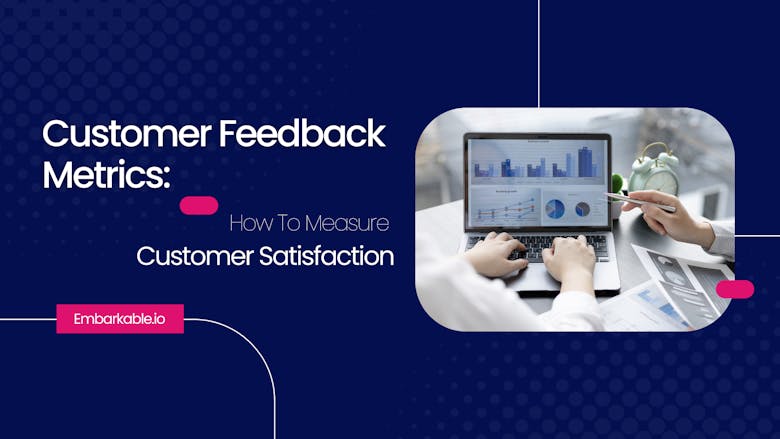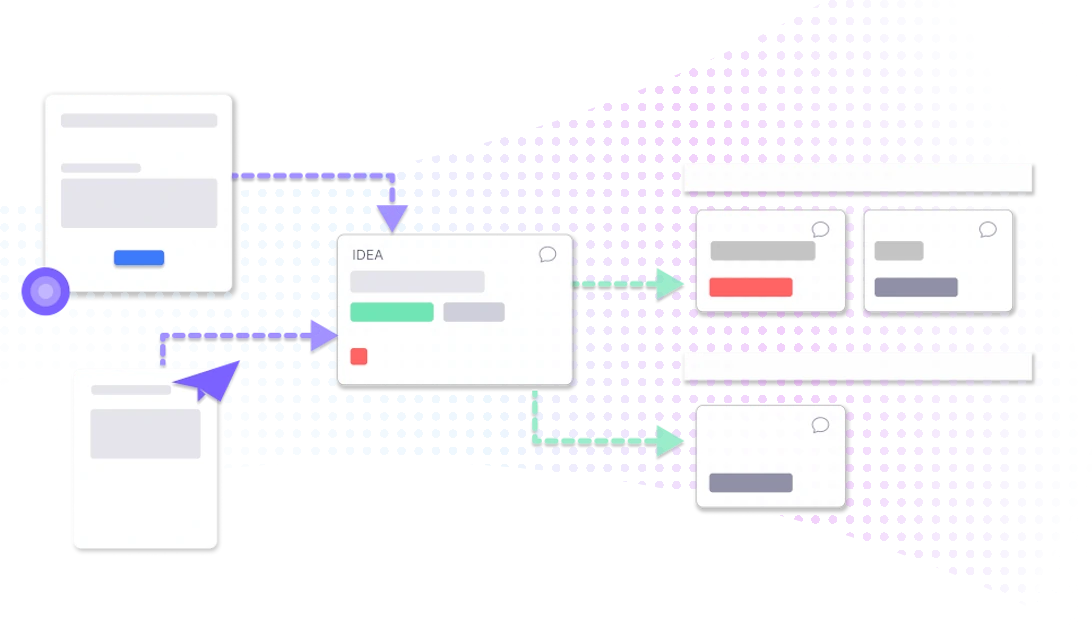Customer Feedback Metrics: How to Measure Customer Satisfaction

Customer feedback metrics are essential for gauging overall customer satisfaction and determining the how well your product is meeting their needs. By understanding your customers’ needs and how they feel about your product, you can create a feedback loop that improves both customer satisfaction and growth. There are a variety of customer feedback metrics to choose from - we'll discuss the pros and cons of all of them.
What Is Customer Satisfaction?
Customer satisfaction describes how happy the customers are with your product. Customer satisfaction is important because it can lead to increased retention, positive reviews, referral opportunities, and ultimately, more revenue.
We will focus on customer satisfaction metrics that can be measured quantitatively. A key benefit of quantitative metrics is that they can be tracked over time to inform you if satisfaction is trending upwards or downwards.
Here are the most common customer satisfaction metrics:
Net Promoter Score® (NPS)
The Net Promoter Score (NPS) is a metric that gauges customer loyalty and satisfaction. The score is based on a single question: "How likely are you to recommend our company/product/service to a friend or colleague?" Respondents are then asked to rate their likelihood on a scale from 0-10. Customers who respond with a 9 or 10 are considered promoters, customers who respond with a 7 or 8 are considered passives, and customers who respond with a 6 or below are considered detractors.
The Net Promoter Score is a metric to calculate customer loyalty. It is calculated by subtracting the percentage of customers who are detractors (those who give a rating of 6 or lower) from the percentage of customers who are promoters (those who give a rating of 9 or higher). The score can range from -100 (all detractors) to 100 (all promoters).
NPS is used to measure customer loyalty over time, as well as to compare customer loyalty between different products or services. NPS has been shown to be a strong predictor of customer churn and revenue growth.
Customer Satisfaction Score (CSAT)
The customer satisfaction score (CSAT) is a metric used to measure the level of customer satisfaction with a given product or service. Like NPS, CSAT is just one question: “How would you rate your overall satisfaction with the service?”
CSAT could be used to assess the overall satisfaction of your product, but can also adjust the question to measure various different individual interactions, including:
- An interaction with customer service
- Completing a specific task within the product
- Completing the onboarding sequence in a product
- Sales interactions
To successfully measure CSAT, the question should be asked when the interaction is still fresh.
Typically, CSAT is measured on a scale from 1 to 10, with 10 representing the highest level of satisfaction (very satisfied), and 1 being very unsatisfied. The survey can also be conducted on a 1 to 5 scale, or 1 to 3 scale, or with emojis. The CSAT score is calculated by averaging the value of all respondents, and is usually represented as a percentage.
The CSAT score can be used to track customer satisfaction over time, as well as compare levels of satisfaction between different products or services. One of the benefits of using CSAT is that it's easy to understand.
Customer Effort Score (CES)
The customer effort score (CES) is a metric used to measure how much friction there is for customers to interact with your product. CES is calculated by asking a simple question along the lines of, "How easy was it to interact with our product?" Survey responses are on a scale of Very Difficult, Difficult, Neutral, Easy, and Very Easy to indicate their level of effort depending on the type of interaction they undertook.
Like CSAT, the value of CES really shines when targeting the question towards a specific interaction. CES is more geared towards assessing the pains that your customer experiences, and is key towards reducing friction.
NPS, CSAT and CES – The Bottom Line
NPS, CSAT, and CES are all valuable metrics for measuring customer satisfaction. However, they should not be used in isolation, as they provide different insights into customer sentiment. NPS is a good metric for overall customer satisfaction, CSAT is good for measuring customer satisfaction with individual customer interactions, and CES is good for tracking customer experience over time. Businesses should use all three metrics to get a complete picture of customer satisfaction.
Customer Churn Rate (CCR)
Churn, or the percentage of customers who leave your product in a given period of time, is one of the most important metrics for a SaaS product to track (lower churn is better). CCR is used as a gauge of customer loyalty and can be helpful in predicting future revenue. Factors that contribute to customer churn include poor customer service, lack of satisfaction with the product or service, and high prices.
It can be costly to acquire new customers, so it's important to retain the ones you have. Churn can also be a sign that something is wrong with your product, or that it is not delivering enough value. While this is a key metric that impacts the bottom line, it is a lagging indicator of your product's health, and you will want to track other metrics in parallel to keep a pulse on your business.
Product-Market Fit
Product market fit is an important goal for a startup. Product market fit does not have a hard and fast definition - it is more of a feeling. It is a state in which you are gaining customers faster than you can handle them. Revenue is increasing, and accelerating. You're hiring as fast as you can to keep up with the increased support load and development needs.
As we mentioned, there is no official definition or metric of product market fit, but one method proposed by Sean Ellis is to survey your users and ask just one question: "How would you feel if you could no longer use the product?" with the possible responses as follows:
- Very disappointed
- Somewhat disappointed
- Not at all disappointed
- N/A (No longer use the product)
If 40% or more of respondents answer "Very disappointed', you've got product market fit! If you don't yet have product market fit, you'll likely want to achieve it as soon as possible, making this a fantastic metric to track over time.
The benefits of tracking customer feedback metrics
Tracking customer satisfaction have a number of benefits:
- Identify and fix issues before they become bigger problems.
- See the effects of their marketing and product efforts.
- Measure the success of their customer service policies.
- Identify problem customers and make changes to avoid future issues.
- Tracking customer satisfaction helps to build trust between companies and their customers.
In addition, by paying attention to a metric and actively trying to increase it over time, you will naturally see an improvement in other metrics as well:
Increased user engagement, loyalty, and customer retention
Engaged customers are more likely to stick around and be loyal customers to your product. There are many ways to measure engagement, including things like customer loyalty programs, frequency of use, and average spend per customer.
If you're looking to improve customer satisfaction metrics, you need to increase engagement. And the best way to do that is by fostering loyalty. When customers feel a sense of loyalty to your brand, they're more likely to stick around and continue doing business with you. They're also more likely to recommend your company to others and write positive online reviews for you.
There are a number of things you can do to foster loyalty among your customers. First, make sure they feel valued. Make sure they know that you appreciate their business and that you're committed to providing them with the best possible experience. The key is to create a real customer relationship with them. Second, make it easy for them to do business with you. Make sure your website is easy to navigate, your checkout process is simple, and your customer service is responsive. Third, offer them incentives to stay loyal. Offer them discounts, rewards points, or special offers for repeat customers.
Word-of-mouth marketing
Customers who are satisfied with their interactions with a company are more likely to recommend that company to others. This increase in word-of-mouth marketing can result in an increase in revenue and growth for a company. In addition, companies that focus on satisfaction also tend to have lower employee turnover rates and lower customer complaint rates. Satisfied employees are more likely to be creative and innovative, which can lead to increased productivity.
Increase sales and upsell opportunities
Increasing sales and upsell opportunities begins with customer satisfaction. Satisfied customers are more likely to return, and they're also more likely to recommend your business to others. Satisfied customers are also more likely to buy additional products or services from you. In fact, a study by Bain and Company has shown that increasing customer satisfaction by just 5 percent can lead to a 25 percent increase in profit.
Make sure you take the time to understand your customers' needs and wants so that you can create the most positive customer experience. This includes offering quality products and services, addressing customer concerns quickly and effectively, delivering on promises, and exceeding customer expectations.
How to improve customer satisfaction metrics?
The best thing you can do to improve satisfaction metrics is to ask follow up questions. This allows you to get a more complete understanding of what the customer wants and insights into how they feel about your product. It's best to include an open-ended follow up question to any of these survey metrics, to ask about why the user answered the way they did. Regardless of whether the response was positive or negative, you will gain insight into what you are doing right or wrong.
Look for trends in the open-ended responses, and focus on the negative respondents. This will help you identify what you need to improve. For example, if you have developed an add-on and some customers are saying they won’t use it because of the cost, then you need to consider your pricing strategy. Or, if many users are mentioning the same frustration when using your product, consider changing the design of the feature.
For specific individuals who provided negative responses, you have the opportunity to address any complaints or concerns that the customer may have. Providing outstanding customer service to a customer that rated your product poorly could improve their opinion of your product and your company. They may even become an advocate!
Customer segmentation will help to analyze customer satisfaction metrics over your most valuable customer segments. Make sure to review your metrics across different segments to look for differences.
Start leveraging customer feedback metrics for real results
In conclusion, customer feedback metrics are essential for understanding how customers interact with your product or service. By tracking and analyzing this data, you can make necessary changes to improve customer satisfaction and boost your bottom line. So start leveraging customer feedback metrics today and see real results!
Embarkable: Turn feedback into action

Embarkable is a product management platform that connects customer feedback to product goals to help you decide what to build, and why. It lets you consolidate feedback from many different sources so that you'll have more confidence in what to build, and a stronger understanding of your customer needs. Spend less time searching for the right insight, more time building the feature that makes the customer happy, and drive your business forward.
In addition to building roadmaps and managing product launches, Embarkable allows you to monitor a single stream of incoming feedback to keep a pulse on what users are saying - something that would be much too time consuming to do manually. When you have different team members handling support or social media, Embarkable offers peace of mind because you'll know that critical feedback isn't falling through the cracks.